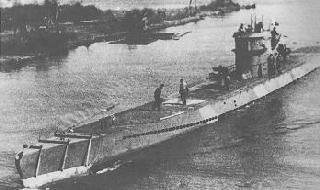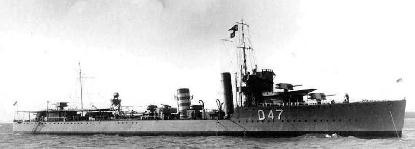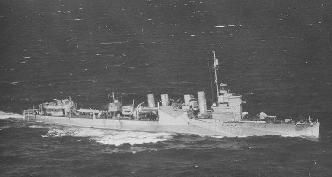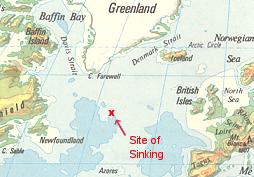

|
Sinking of U-187
The U-187, a Type IXC/40 under the command of KL Ralph Munnich departed Kiel on its first war patrol on 12th January 1943. Shortly after departure, BdU received intelligence reports of convoy SC-118, which is suspected to be using the North Atlantic route.

|
| A Type IXC Class U-boat, of which the U-187 was one of. |
In response to the intelligence reports, Donitz formed a patrol line, the Pfeil wolfpack. Consisting of 13 U-boats, the U-187 was one of the boats in this pack tasked to intercept the convoy. The convoy was not sighted until 4th February, when a starburst was spotted by U-187. It is believed that it was fired by one of the merchant ships. U-187 sends a contact report and unfortunately for her, one of the ships in the convoy had HF/DF direction finding equipment. The source of the transmission is tracked down and two destroyer escorts, HMS Vimy and HMS Beverley were sent to intercept.

|
| U-187 was sunk by HMS Vimy, an Admiralty V & W Class destroyer which was escorting convoy SC-118. |
What happened after that is on the account of the 2WO Hans Georg, with his report (translated) :-
I was on the bridge when convoy SC-118 was sighted. After sending a contact report, a destroyer was spotted knifing directly towards us. The commander ordered a dive and the moment the hunt began, we were pounded with depth charges. We launched noise decoys to confuse our pursuers, however these did not last very long. Soon, we could hear pinging pulses from the enemy above as they tried to get a fix on our location. Then depth charges began exploding and this pinging and depth charge attacks continued on and on. Meanwhile, the entire crew were steadfast and unwavering in their positions. A few depth charges exploded close to us and the boat started taking on water. Oil pipes also ruptured, spewing oil at the location where I was, in the center of the boat. Other sections of the boat also began to take damage. The leading engineer and his men did everything they could to plug the leaks, but the water kept pouring in and the boat became bow heavy. We began to list. From the control room, I could see that the depth gauge was maxed out, which was 280 meters. Noises of the hull creaking and cracking under stress of the water pressure was very discernable. At about this time, another depth charge attack took place. And also around this time, the leading engineer reported “commander, I can not hold the boat any longer”. Thereafter, the commander ordered to surface and for the crew to fasten life jackets. Ballast tanks were blown, but in a very dramatic moment, the compressed air cells would not blow. They had been severely damaged. Fortunately, the last compressed air cell worked. The commander opened the hatch, and the crew exited in a calm and orderly manner. They jumped into the water as soon as they got out. My last sight from where I was, although my view was obstructed, I could see the crew in the control room struggling to keep the boat afloat long enough so that everybody could exit. When I came out, I saw the destroyer. It opened fire with all guns blazing, firing at the sinking boat and at the men already in the water. Many had already exit from the boat, and perhaps many others could not exit from the boat due to the gun fire. I do not know. What I do know, is that the leading engineer remained in the boat and went down with it.
I was with some other crew members, and many others became separated, so I do not know how many survived. Although I have no complains about the treatment aboard the destroyer, but I protest the fact that the HMS Beverley fired not only at the sinking boat, but also at the men in the water. When I heard that Admiral Donitz was charged in Nuremberg for similar crimes, how can it come to be when the British commander did the same thing, and I was the witness. I do not believe that the English authorities were not aware of it.

|

|
| Town Class destroyer, similar to HMS Beverley. Ironically, the HMS Beverley was torpedoed by U-188 about a month later and sank with the loss of all but four of its 155 crewmen. | Location map of the sinking site (German Grid BD1276). |
U-187 - Type IXC/40 |
|
| Commander
KL Ralph Munnich Birth: 11 Feb 1916 Death: 4 Feb 1943 U-Boat Type IXC/40 Built By: Deschimag AG Weser, Bremen Commissioned: 23rd Jul 1942 Flotilla 4th U-Flotilla (23 Jul 42 – 31 Dec 42) 10th U-Flotilla (1 Jan 43 – 4 Feb 43) Combat Service War Patrols: 1 Patrol 12 Jan 1943 - 4 Feb 1943 War Successes: None Fate Located by HF/DF while shadowing convoy SC-118. Attacked by depth charges from the HMS Vimy and HMS Beverley. Sunk on 4th February 1943 in the North Atlantic, south of Greenland at the exit of the Baffin Bay (German grid BD1276). It was her first war sortie. Casualties Nine crew members perished, including the commander during the sinking. Forty five were rescued and taken prisoners. |
Emblem

The emblem of U-187 was a white horse. The commander was recently married at about the time he obtained command. He adopted the emblem after the badge of the famous White Horse Inn in Wolfgangsee, where he had first met his young and beautiful bride. She knitted 45 small white horses, one for each crew of U-187. |



